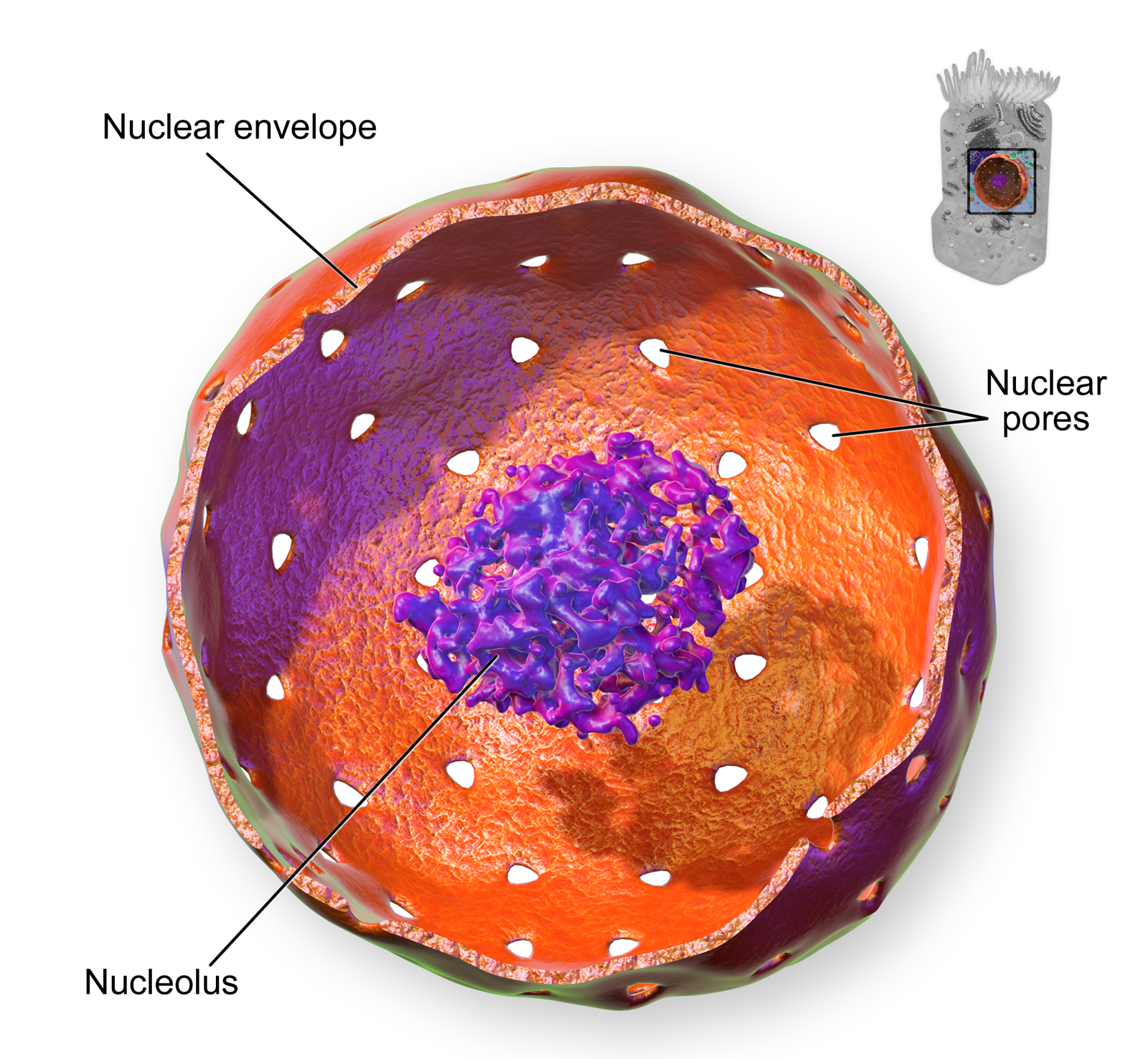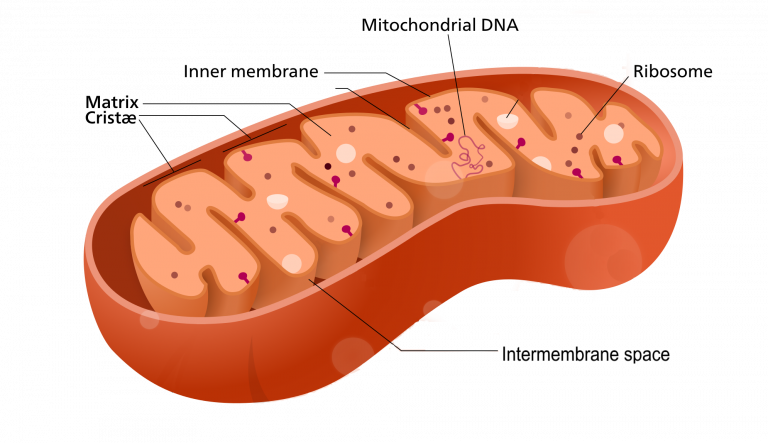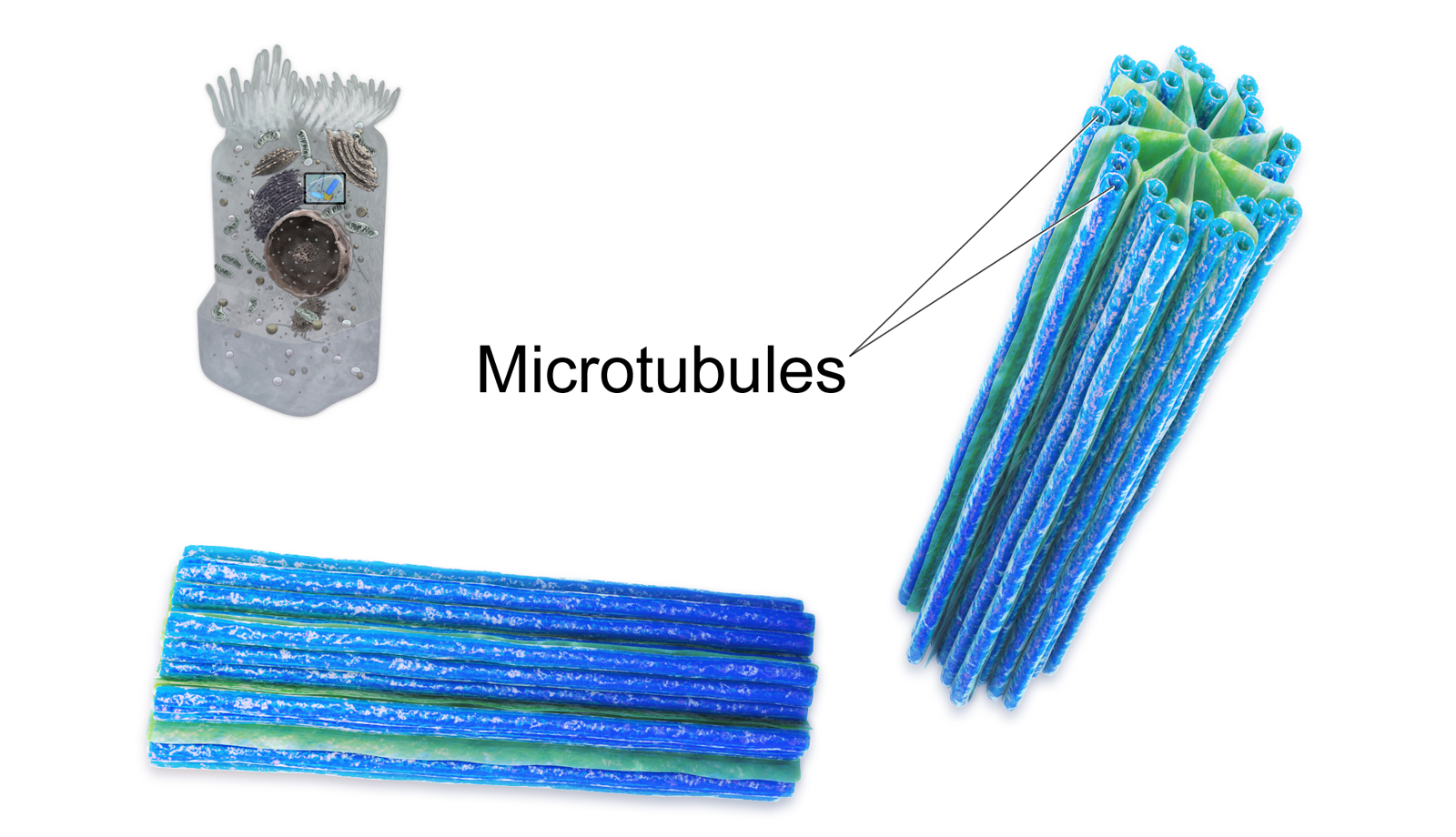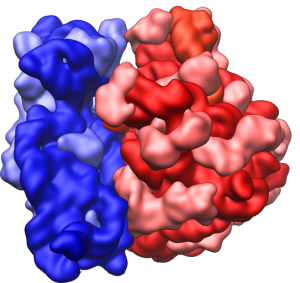4.3 Cell Organelles

An organelle is a structure within the cytoplasm of a eukaryotic cell that is enclosed within a membrane and performs a specific job. Organelles are involved in many vital cell functions. Organelles in animal cells include the nucleus, mitochondria, endoplasmic reticulum, Golgi apparatus, vesicles, and vacuoles. Ribosomes are not enclosed within a membrane but are still commonly referred to as organelles in eukaryotic cells.

The Nucleus
The nucleus is the largest eukaryotic cell organelle and the cell’s control centre. It contains most of the cell’s DNA (which makes up chromosomes) and is encoded with the genetic instructions for making proteins. The function of the nucleus is to regulate gene expression, including controlling which proteins the cell makes. Most eukaryotic cells contain just a single nucleus, but some types of cells (such as red blood cells) contain no nucleus and a few other types of cells (such as muscle cells) contain multiple nuclei.
As shown in the model pictured in Figure 4.3.2, the membrane enclosing the nucleus is called the nuclear envelope. This double membrane encloses the entire organelle and isolates its contents from the cellular cytoplasm. Tiny holes called nuclear pores allow large molecules to pass through the nuclear envelope with the help of special proteins. Large proteins and RNA molecules must be able to pass through the nuclear envelope so that proteins can be synthesized in the cytoplasm and the genetic material can be maintained inside the nucleus. The nucleolus is the dense region within the nucleus where ribosomal subunits are synthesized. After being produced in the nucleolus, ribosomes are exported to the cytoplasm, where they are assembled and used for synthesizing proteins.
Mitochondria

The mitochondrion (plural, mitochondria) is an organelle that makes energy available to the cell. This is why mitochondria are sometimes called the “power plants of the cell.” They use energy from organic compounds (such as glucose) to make molecules of ATP (adenosine triphosphate), an energy-carrying molecule that is used almost universally inside cells for energy.
Mitochondria (as in Figure 4.3.3) have a complex structure, including an inner and outer membrane. In addition, mitochondria have their own DNA, ribosomes, and a version of cytoplasm called the matrix. Does this sound similar to the requirements for being considered a cell? That’s because they are!
Scientists think mitochondria were once free-living organisms because they contain DNA. They theorize that ancient prokaryotes infected (or were engulfed by) larger prokaryotic cells, and the two organisms developed a symbiotic relationship that benefited both of them. The larger cells provided the smaller prokaryotes with a place to live. In return, the larger cells got extra energy from the smaller prokaryotes. Eventually, the smaller prokaryotes became permanent guests of the larger cells, as organelles inside them. This theory is called endosymbiotic theory and is widely accepted by biologists today.
Endoplasmic Reticulum
The endoplasmic reticulum (ER) is an organelle that helps make and transport proteins and lipids. There are two types of endoplasmic reticulum: rough endoplasmic reticulum (rER) and smooth endoplasmic reticulum (sER). Both types are shown in Figure 4.3.4.
- rER looks rough because it is studded with ribosomes. It provides a framework for the ribosomes, which make proteins. Bits of its membrane pinch off to form tiny sacs called vesicles, which carry proteins away from the ER.
- sER looks smooth because it does not have ribosomes. sER makes lipids, stores substances, and plays other roles.
Golgi Apparatus
The Golgi apparatus is a large organelle that processes, modifies, and packages proteins for use inside the cell or for export outside the cell. It functions like a post office: It receives items (proteins from the ER), modifies them (such as adding carbohydrate groups), packages them (into vesicles), and labels them for delivery to their correct destinations (to different parts of the cell or to the cell membrane for transport out of the cell). The Golgi apparatus is also involved in transporting lipids around the cell.
Vesicles and Vacuoles
Both vesicles and vacuoles are sac-like organelles made of phospholipid bilayers that store and transport materials in the cell. Vacuoles are larger and are primarily used for storage. Vesicles are much smaller than vacuoles and have a variety of functions. The vesicles that pinch off from the ER and Golgi apparatus membranes store and transport protein and lipid molecules. You can see an example of this type of transport vesicle in Figure 4.3.4. Some vesicles are used as chambers for biochemical reactions.
There are some vesicles which are specialized to carry out specific functions. Lysosomes, which use enzymes to break down foreign matter and dead cells, have a double membrane to ensure their contents don’t leak into the rest of the cell.
Centrioles

Centrioles are organelles involved in cell division. The function of centrioles is to help organize the chromosomes before cell division occurs so that each daughter cell has the correct number of chromosomes after the cell divides. Centrioles are found only in animal cells and are located near the nucleus. The centriole is cylindrical in shape and consists of many microtubules, as shown in the model pictured in Figure 4.3.5.

Ribosomes
Ribosomes are small structures where proteins are synthesized. Although they are not enclosed within a membrane, they are often considered organelles due to their essential role in the cell. Each ribosome is made up of two subunits (Figure 4.3.6), both composed of ribosomal RNA (rRNA) and proteins.
The genetic instructions from DNA in the nucleus are copied onto messenger RNA (mRNA), which travels to the ribosome. There, the ribosome reads the mRNA sequence and assembles amino acids in the correct order to build a protein. Ribosomes can be found floating freely in the cytoplasm or attached to the rough endoplasmic reticulum (rER).
Plant Cells
Plant cells have some additional organelles that animals do not, including a cell wall, chloroplasts, and a large central vacuole.

Cell Wall
The cell wall is a rigid covering that protects the cell, provides structural support, and gives shape to the cell. Fungal and protist cells also have cell walls.
The major organic molecule in a plant cell wall is cellulose, a polysaccharide made up of long, straight chains of glucose units. When nutritional information refers to dietary fibre, it refers to the cellulose content of food.

Chloroplasts
Chloroplasts function in photosynthesis and can be found in eukaryotic cells such as plants and algae. In photosynthesis, carbon dioxide, water, and light energy are used to make glucose and oxygen. This is the major difference between plants and animals: Plants are able to make their own food, like glucose, whereas animals must rely on other organisms for their organic compounds or food source.
Like mitochondria, chloroplasts also have their own DNA and ribosomes, suggesting they evolved through the endosymbiotic theory. Chloroplasts have outer and inner membranes. The inner membrane encloses a fluid called the stroma. Within the stroma is a set of interconnected and stacked membrane sacs called thylakoids (Figure 4.3.8). The chloroplasts contain a green pigment called chlorophyll, which captures the energy of sunlight for photosynthesis.
Large Central Vacuole
Plant cells each have a large central vacuole that occupies most of the cell. The central vacuole plays a key role in regulating the cell’s water concentration in changing environmental conditions. The liquid inside the central vacuole provides turgor pressure, which is the outward pressure caused by the fluid inside the cell. This fluid may also have a bitter taste or even contain toxins to discourage insects and animals from eating the plant. The large central vacuole can also store pigments, which give flowers their vibrant colours, and help to attract pollinators. It also stores proteins in developing seed cells.
Exercise 4.3.1
Text Description
- The _____ contains the genetic instructions for the production of proteins.
- The _____ organizes chromosomes before cell division.
- The _____ is covered in attached ribosomes.
- The _____ packages and modifies proteins.
- The _____ assembles ribosomes.
- The _____ use energy from glucose to make molecules of ATP.
- The _____ synthesizes lipids.
- mitochondria
- centrioles
- nucleolus
- smooth ER
- Golgi apparatus
- rough ER
- nucleus
- The nucleus contains the genetic instructions for the production of proteins.
- The centrioles organize chromosomes before cell division.
- The rough ER is covered in attached ribosomes.
- The Golgi apparatus packages and modifies proteins.
- The nucleolus assembles ribosomes.
- The mitochondria use energy from glucose to make molecules of ATP.
- The smooth ER synthesizes lipids.
“4.6 Cell Organelles” from Human Biology by Christine Miller is licensed under a Creative Commons Attribution-NonCommercial 4.0 International License, except where otherwise noted.
“3.3 Eukaryotic Cells” from Biology and the Citizen by Colleen Jones is licensed under a Creative Commons Attribution 4.0 International License, except where otherwise noted.

